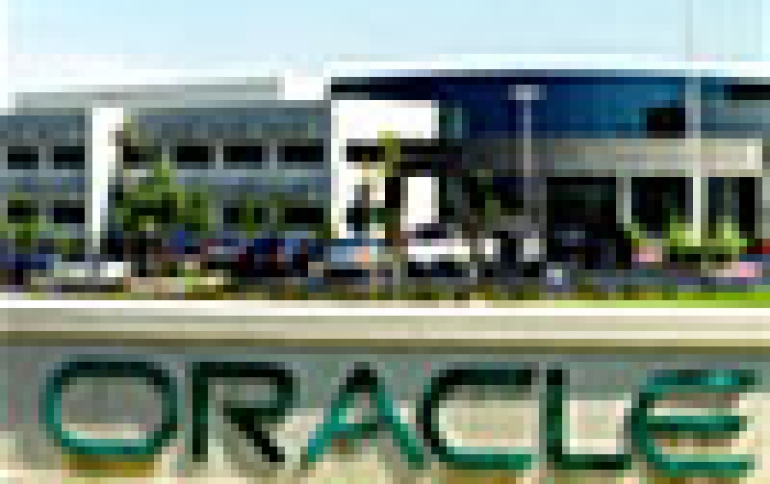
Oracle Unveils Exalogic Elastic Cloud, MySQL 5.5 RC
Oracle today unveiled Exalogic Elastic Cloud, a new all-in-one product to help companies manage so-called "cloud" computing.
The worlds first integrated middleware machine, Oracle Exalogic Elastic Cloud, was announced today at Oracle OpenWorld 2010 by Oracle Chief Executive Officer, Larry Ellison.
Oracle Exalogic Elastic Cloud is an integrated hardware and software system engineered, tested, and tuned by Oracle to run Java and non-Java applications with extreme performance. The machine provides a complete cloud application infrastructure, consolidating the widest possible range of Java and non-Java application types and workloads.
Building on the success of the Oracle Exadata Database Machine, Oracle Exalogic Elastic Cloud combines 64-bit x86 processors, an InfiniBand-based I/O fabric and solid-state storage with the Oracle WebLogic Server, other enterprise Java Oracle middleware products and a choice of Oracle Solaris or Oracle Linux operating system software.
The software has been tuned to exploit the I/O fabric in the Oracle Exalogic Elastic Cloud machine in order to deliver performance results 10x better than a standard application server configuration, Oracle claims.
Engineered for large-scale, mission-critical deployments, Oracle Exalogic Elastic Cloud can support thousands of applications with differing security, reliability, and performance requirements. It accelerates the performance of the entire Oracle Fusion Middleware product portfolio and also increases the performance of applications running on Oracle WebLogic Server with either Oracle Linux or Oracle Solaris 11. The machine is also optimized for integration with Oracle Database 11g, Oracle Real Application Clusters and the Oracle Exadata Database Machine.
Any Oracle Applications including: the Oracle E-Business Suite, Oracles Siebel CRM, Oracles PeopleSoft Enterprise, Oracles JD Edwards and Oracles industry specific business applications will run on Oracle Exalogic Elastic Cloud transparently, without needing any modifications.
Oracle Exalogic Elastic Cloud comprises the latest high performance x86 hardware, the Oracle WebLogic Server, and Exalogic software, all engineered by Oracle for maximum capability with minimum set-up. It is assembled, tested and tuned at the factory to dramatically reduce the time from machine delivery to fully operational application deployment.
In Oracles internal testing one rack of Oracle Exalogic Elastic Cloud demonstrated:
- 12X improvement for Internet applications, to over 1 Million HTTP requests per second.
- 4.5X improvement for Java messaging applications, to over 1.8 Million messages per second.
The InfiniBand-based I/O fabric, builds on the raw I/O performance of native InfiniBand, implementing a new architecture for parallel I/O, multi-core processor efficiency and optimization of the Java I/O stack.
Oracle Exalogic Elastic Cloud is a Java application consolidation platform capable of serving the workloads of the entire enterprise--from small departmental applications to missioncritical enterprise resource planning infrastructures to re-hosted mainframe applications.
The GridLink for Exadata feature provides reliable and high-performance database integration, enabling instantaneous JDBC connection failover and transaction affinity between Oracle WebLogic Server running on Exalogic and Oracle Real Application Clusters running on an Oracle Exadata Database Machine.
Exalogics I/O fabric technology enables a high level of fault tolerance with near-instant failover and 100% isolation of applications, allowing enterprises to consolidate numerous mission-critical applications on a single system with extremely low risk.
Oracle competes with European software giant SAP AG and International Business Machines (IBM) in the business software and database products markets.
MySQL 5.5 Release Candidate
Oracle also announced the availability of the release candidate for MySQL 5.5, the popular open-source database, licensed under the GNU General Public License (GPL).
Announced during the first MySQL Sunday event at Oracle OpenWorld, the MySQL 5.5 release candidate showcases the latest enhancements in performance and scalability, availability and usability.
Enhancements include:
MySQL Server and InnoDB have been enhanced to provide optimum performance and scalability when running on the latest multi-CPU and multi-core hardware and operating systems.
InnoDB is now the default storage engine for MySQL Server, delivering ACID transactions, referential integrity, and crash recovery.
New semi-synchronous replication improves failover reliability by allowing the master to proceed without waiting for all the slaves to acknowledge. Once one slave acknowledges, the transaction can be committed. This also helps improve data integrity.
Replication Heart Beat enables faster detection, diagnosis and correction of master/slave synchronization issues, helping improve the reliability and availability of data by reducing the risk and impact of master/slave synchronization issues.
Improved index and table partitioning enables RANGE and LIST partitions to be defined on date, datetime, varchar, and char columns, simplifying and extending MySQL and adding flexibility to indexing and query tuning.
DBAs and developers can save time using the ANSI/ISO standard SIGNAL/RESIGNAL syntax inside stored routines, including triggers, to raise an error condition invoking specific error handling within their applications.
Enhanced diagnostics, including a new ERFORMANCE_SCHEMA, provide low-level diagnostics on MySQL server performance statistics, allowing DBAs to pinpoint resource-intensive processes and events, streamlining efforts and helping to enhance their productivity.
In recent benchmarks using the release candidate for MySQL 5.5, compared to MySQL 5.1, results demonstrated marked performance improvements:
- On Windows: up to 1,500 percent performance gains for Read/Write operations, and up to 500 percent gain for Read Only.
- On Linux: up to 360 percent performance gain in Read/Write operations and up to 200 percent improvement in Read Only.
Oracle Exalogic Elastic Cloud is an integrated hardware and software system engineered, tested, and tuned by Oracle to run Java and non-Java applications with extreme performance. The machine provides a complete cloud application infrastructure, consolidating the widest possible range of Java and non-Java application types and workloads.
Building on the success of the Oracle Exadata Database Machine, Oracle Exalogic Elastic Cloud combines 64-bit x86 processors, an InfiniBand-based I/O fabric and solid-state storage with the Oracle WebLogic Server, other enterprise Java Oracle middleware products and a choice of Oracle Solaris or Oracle Linux operating system software.
The software has been tuned to exploit the I/O fabric in the Oracle Exalogic Elastic Cloud machine in order to deliver performance results 10x better than a standard application server configuration, Oracle claims.
Engineered for large-scale, mission-critical deployments, Oracle Exalogic Elastic Cloud can support thousands of applications with differing security, reliability, and performance requirements. It accelerates the performance of the entire Oracle Fusion Middleware product portfolio and also increases the performance of applications running on Oracle WebLogic Server with either Oracle Linux or Oracle Solaris 11. The machine is also optimized for integration with Oracle Database 11g, Oracle Real Application Clusters and the Oracle Exadata Database Machine.
Any Oracle Applications including: the Oracle E-Business Suite, Oracles Siebel CRM, Oracles PeopleSoft Enterprise, Oracles JD Edwards and Oracles industry specific business applications will run on Oracle Exalogic Elastic Cloud transparently, without needing any modifications.
Oracle Exalogic Elastic Cloud comprises the latest high performance x86 hardware, the Oracle WebLogic Server, and Exalogic software, all engineered by Oracle for maximum capability with minimum set-up. It is assembled, tested and tuned at the factory to dramatically reduce the time from machine delivery to fully operational application deployment.
In Oracles internal testing one rack of Oracle Exalogic Elastic Cloud demonstrated:
- 12X improvement for Internet applications, to over 1 Million HTTP requests per second.
- 4.5X improvement for Java messaging applications, to over 1.8 Million messages per second.
The InfiniBand-based I/O fabric, builds on the raw I/O performance of native InfiniBand, implementing a new architecture for parallel I/O, multi-core processor efficiency and optimization of the Java I/O stack.
Oracle Exalogic Elastic Cloud is a Java application consolidation platform capable of serving the workloads of the entire enterprise--from small departmental applications to missioncritical enterprise resource planning infrastructures to re-hosted mainframe applications.
The GridLink for Exadata feature provides reliable and high-performance database integration, enabling instantaneous JDBC connection failover and transaction affinity between Oracle WebLogic Server running on Exalogic and Oracle Real Application Clusters running on an Oracle Exadata Database Machine.
Exalogics I/O fabric technology enables a high level of fault tolerance with near-instant failover and 100% isolation of applications, allowing enterprises to consolidate numerous mission-critical applications on a single system with extremely low risk.
Oracle competes with European software giant SAP AG and International Business Machines (IBM) in the business software and database products markets.
MySQL 5.5 Release Candidate
Oracle also announced the availability of the release candidate for MySQL 5.5, the popular open-source database, licensed under the GNU General Public License (GPL).
Announced during the first MySQL Sunday event at Oracle OpenWorld, the MySQL 5.5 release candidate showcases the latest enhancements in performance and scalability, availability and usability.
Enhancements include:
MySQL Server and InnoDB have been enhanced to provide optimum performance and scalability when running on the latest multi-CPU and multi-core hardware and operating systems.
InnoDB is now the default storage engine for MySQL Server, delivering ACID transactions, referential integrity, and crash recovery.
New semi-synchronous replication improves failover reliability by allowing the master to proceed without waiting for all the slaves to acknowledge. Once one slave acknowledges, the transaction can be committed. This also helps improve data integrity.
Replication Heart Beat enables faster detection, diagnosis and correction of master/slave synchronization issues, helping improve the reliability and availability of data by reducing the risk and impact of master/slave synchronization issues.
Improved index and table partitioning enables RANGE and LIST partitions to be defined on date, datetime, varchar, and char columns, simplifying and extending MySQL and adding flexibility to indexing and query tuning.
DBAs and developers can save time using the ANSI/ISO standard SIGNAL/RESIGNAL syntax inside stored routines, including triggers, to raise an error condition invoking specific error handling within their applications.
Enhanced diagnostics, including a new ERFORMANCE_SCHEMA, provide low-level diagnostics on MySQL server performance statistics, allowing DBAs to pinpoint resource-intensive processes and events, streamlining efforts and helping to enhance their productivity.
In recent benchmarks using the release candidate for MySQL 5.5, compared to MySQL 5.1, results demonstrated marked performance improvements:
- On Windows: up to 1,500 percent performance gains for Read/Write operations, and up to 500 percent gain for Read Only.
- On Linux: up to 360 percent performance gain in Read/Write operations and up to 200 percent improvement in Read Only.




















